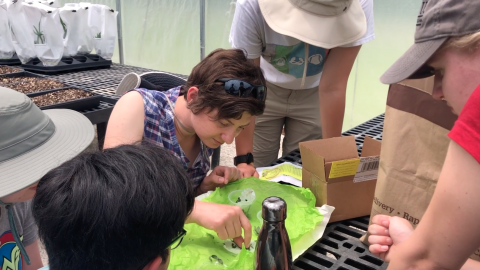Science communications fellow Selaam Dollisso embedded with Tyson Research Center's plant disease team, led by Rachel Penczykowski, to understand their work in the field.
Tyson Research Center is a 2,000-acre forested gem situated near Eureka, Missouri. Each summer, the environmental research station is abuzz with high school, undergraduate, and graduate students, scientists, and faculty of diverse disciplines and interests.
As a member of the science communication team led by Suzanne Loui, lecturer in environmental studies, recent graduate Christian Fogerty and I developed projects to identify methods to best communicate the research happening at Tyson. Both of us shadowed a different research team in order to document and express the human elements that make their scientific work possible. I had the privilege of embedding with the plant disease team, led by Rachel Penczykowski, assistant professor of biology. I worked in the field with the team every day for two weeks while taking notes and capturing photos and video footage.
Penczykowski studies the ecology of infectious diseases, and her experiments at Tyson this summer examined the effect of diseases on food webs. Her focal species is the common roadside weed Plantago lanceolata, which her team experimentally subjected to caterpillar herbivory and pathogenic infection by powdery mildew.
“Learning about how hosts and parasites interact is especially pressing given that different types of human-driven global change are impacting ecological communities, including impacting the frequency of host-parasite interactions and which parasites are interacting with which hosts,” Penczykowski said.
My video highlights the team’s work through a communication channel unconventional for scientific research: videography. I wanted to recreate the observational way that I learned about the team’s research while shadowing them. The storytelling aspect that video provides eases and familiarizes the audience and provides an opportunity for the researchers to learn how to convey their passion and the importance of their research to a lay audience. Effective communication is key to increasing the public’s appreciation for scientific research.




